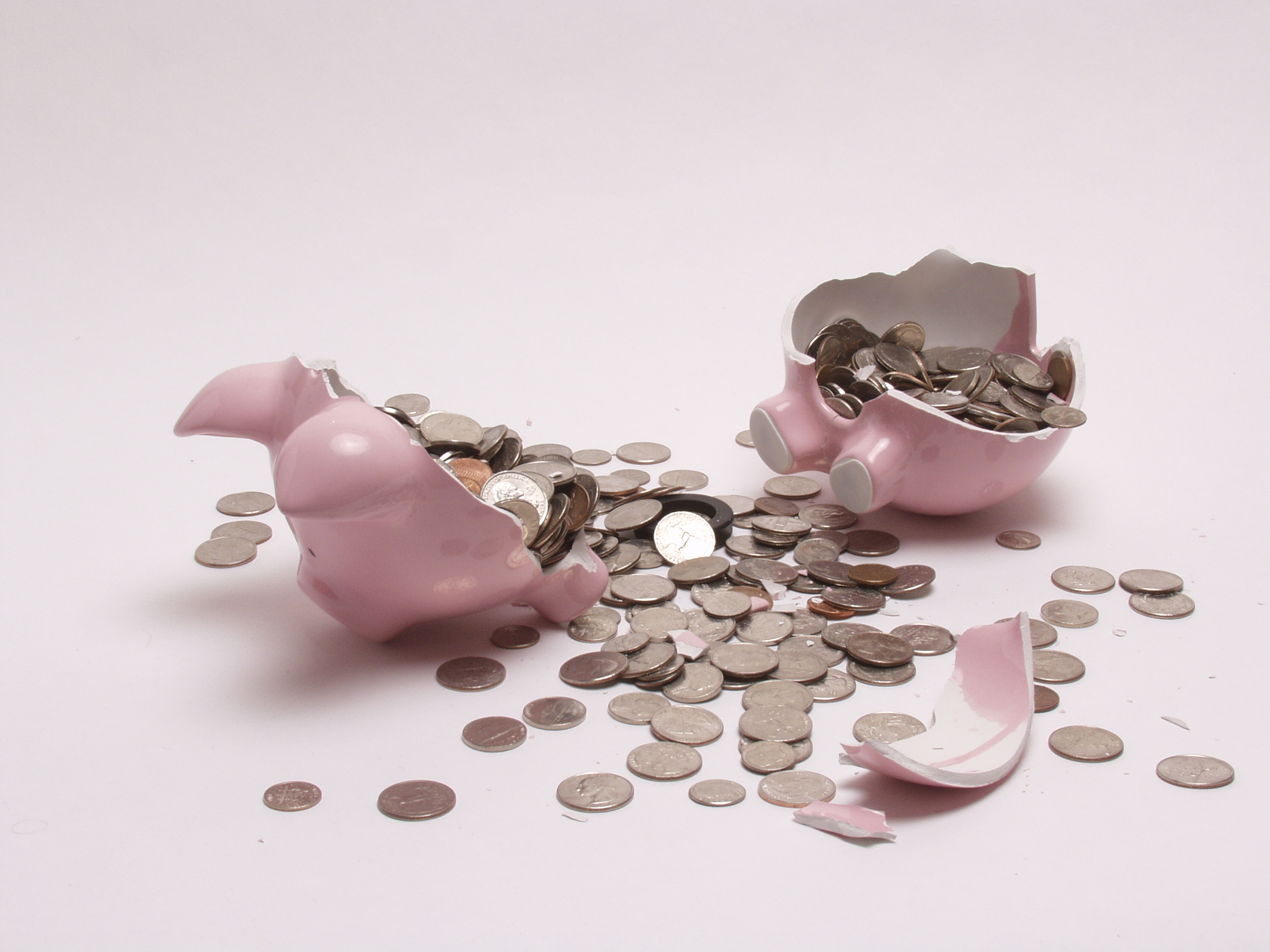The Importance of Personal and National Savings
A busted piggy bank!
Photo Credit: MorgueFile.com/mconnors
This morning I endured a period of cognitive dissonance while reading a May 2015 fortune.com post entitled Are Americans saving too much of their money? by Chris Matthews. In it, Mr. Matthews was worrying about lackluster retail sales that are doing little to boost economic growth. Indeed, there is much to be concerned about, as can be seen from the chart of year-over-year percent change in total retail sales below.

More often than not, these changes have been negative, with the positive changes mostly bounded by one precent YOY growth. With personal consumption historically being about 70% of GDP, this chart all by itself should make us worried about recession being just around the corner.
Matthews then worries if this lack of a healthy volume of sales might be due to the American people saving too much of their money. You may recall that in our post Economic Damage Created by the Fed, a correlation was pointed out between the personal savings rate and long-term interest rates. This correlation was illustrated in a chart that I reproduce below.

Copyright, 2014 OECD bond yield data. Reprinted with permission.
We noted the long-term interest rate had to increase rapidly in the 1970s to keep real long-term rates positive in that highly inflationary period and the savings rate between 10 and 13 percent. After 1981 until the start of the Great Recession in 2007, the savings rate and long-term interest rates were tightly correlated and almost equivalent. The Great Recession temporarily broke this correlation as people saved more to increase their financial security while QE drove real long-term interest down. The personal savings rate then rose from 2.5% in November 2007 to a one month-long sharp peak of 11% in December 2012, after which the personal savings rate started to decay again. If nothing is done to increase real long-term interest rates above the “zero bound”, we have every reason to believe that with no incentive to save, people will have no reason to save and the savings rate will decay to zero.
My cognitive dissonance then was caused by anyone thinking we are saving too much. If anything, we are saving far too little under the influence of the Fed’s corrosive ZIRP and the lasting effects of QE.

The mystery of how Matthews could entertain such an idea was dispelled with his chart from the Federal Reserve Economic Data Base (FRED) of the personal savings rate. Plotting the savings rate from March 1995 to July 2012, he displayed the chart shown to the left. This certainly shows recent large savings rates.
However, recall that personal savings after the Great Recession peaked in December 2012. If we make a plot of the same data from March 1995 to the present, we find the following chart that shows the savings rate beginning to decay again. Chris Matthews just did not go far enough in time to see the savings rate begin to decay again. One might argue the current savings rate of about 4.7% is still too large, but the future cost of deficient savings is so great, such a claim is hard to believe.

So why is the personal savings rate so important? The main reason is that the nation’s savings is what creates new capital for investment. There really is no other source of new capital. The federal government has a negative savings rate (it always runs deficits), so personal savings must work all the harder to overcome the government’s negative savings. A certain fraction of the savings must be used as replacement investment, ri , to replace depreciated physical capital, with the remainder, called net investment ni , being available for investment in new productive capacity for the nation. The nation’s total investment i in any one year must equal the year’s savings s, where i = s = ri + ni. If by chance the savings rate is larger than ri, then there is enough savings left over after replacing depreciated (i.e. worn out or obsolete) capital to allow for new investments and the economy grows. If the savings is less than the required replacement investment, some depreciated productive capacity is not replaced, and the economy shrinks!
Keynesians are always more concerned about stimulating new economic demand than in supplying new productive capacity. More often than not, when conservatives suggest we encourage the formation of new productive capacity in various ways, the progressives ridicule the suggestion as “supply-side economics”. Historically, John Maynard Keynes assumed that in recessions or depressions there was already a great deal of physical capital (machinery, factories, farm land, etc.) lying around unused. Therefore there was no need for new net investment. All the government had to do was stimulate the economy for a short period of time and it would be kicked back into operation, and we could then stop government stimulus and allow the capitalist economy to do its thing. In our current circumstances, however, we have had more than six years of zero real short-term and long-term interest rates! Because our growth rate is so abysmally low, one could be forgiven in suspecting our savings are just barely meeting the requirements of replacement investment. If that is the case, we need to be encouraging savings, not consumption. This means allowing interest rates to rise high enough to incentivize the savings.
Views: 4,252





























